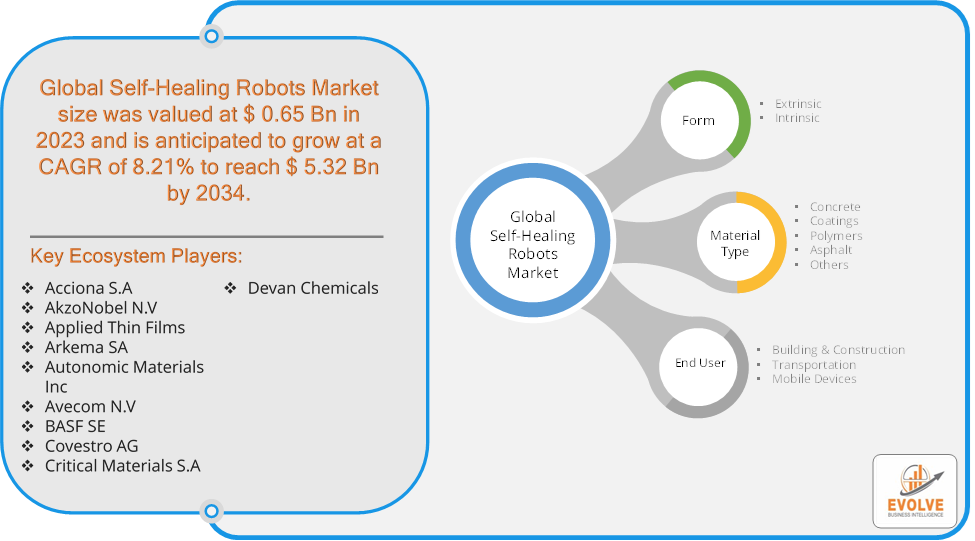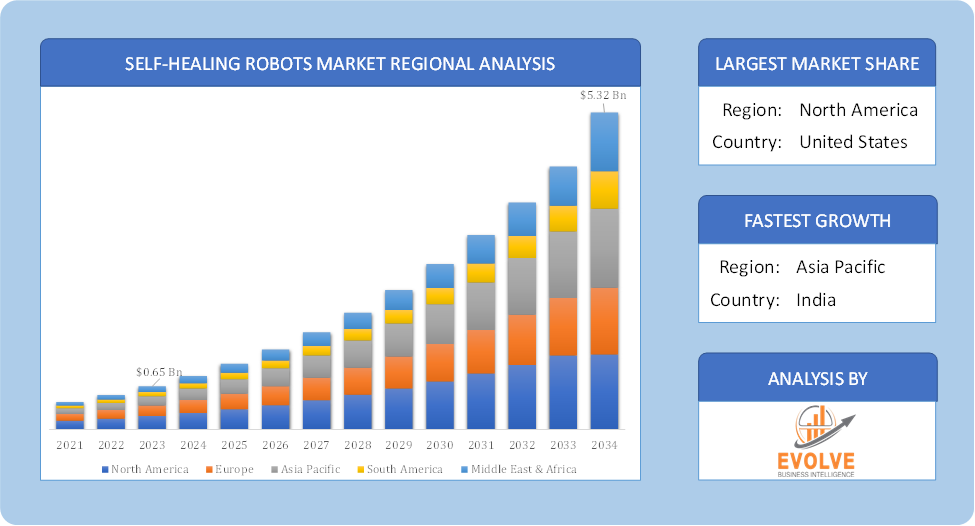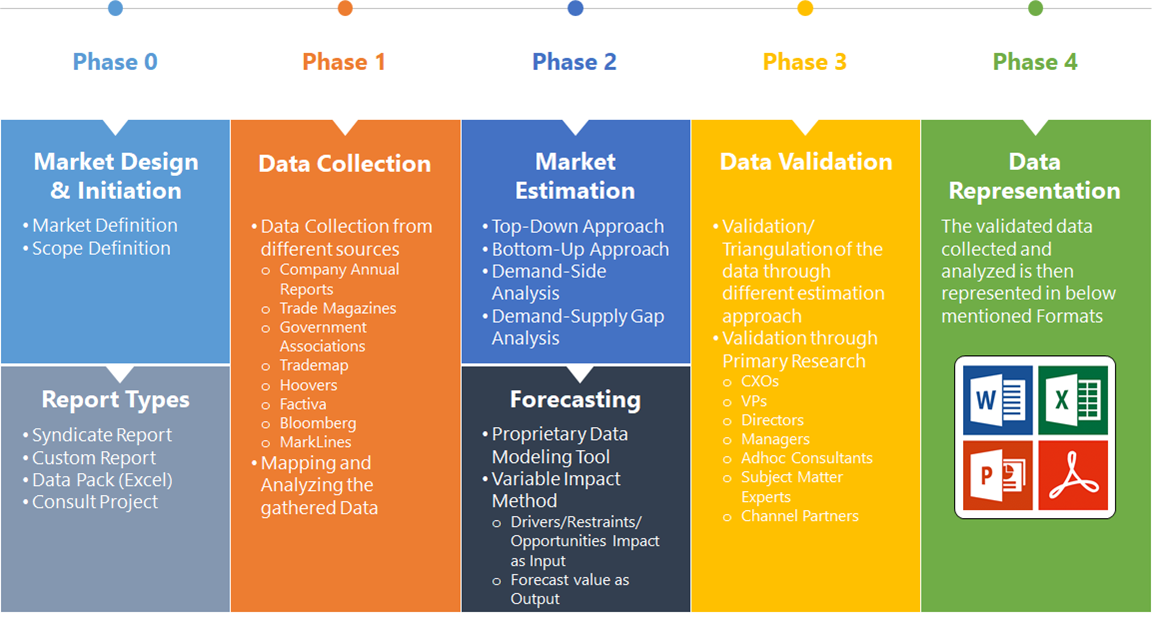Self-Healing Robots Market Overview
The Self-Healing Robots Market Size is expected to reach USD 5.32 Billion by 2034. The Self-Healing Robots Market Industry size accounted for USD 0.65 Billion in 2023 and is expected to expand at a compound annual growth rate (CAGR) of 8.21% from 2021 to 2034. The Self-Healing Robots Market involves the development and commercialization of robots equipped with the ability to autonomously repair or recover from damage. This capability is achieved through advanced materials and technologies that allow robots to detect damage and initiate repair processes without human intervention.
This market is evolving as researchers and companies work to address the challenges and unlock the full potential of self-healing technologies in robotics. As technology continues to advance, we can expect to see even more innovative and capable self-healing robots being developed to address a wide range of needs.
Global Self-Healing Robots Market Synopsis
The COVID-19 pandemic had significant impacts on the Self-Healing Robots Market. The pandemic highlighted the need for automation and remote operations to minimize human contact. This led to a greater interest in advanced robotic technologies, including self-healing robots, which can operate more autonomously and reduce the need for human intervention. The urgency of dealing with health crises and disruptions in supply chains accelerated innovation in robotics, including self-healing technologies. Researchers and companies were motivated to develop more resilient and adaptable systems. There was an increased focus on healthcare robotics due to the pandemic, driving interest in robots that can handle hazardous environments and perform tasks autonomously. Self-healing robots, with their resilience and reliability, became more relevant in this context. The pandemic caused significant disruptions in global supply chains, affecting the availability of materials and components needed for the development and production of self-healing robots. This led to delays and increased costs.
Self-Healing Robots Market Dynamics
The major factors that have impacted the growth of Self-Healing Robots Market are as follows:
Drivers:
Ø Advancements in Materials Science
Breakthroughs in self-healing materials, such as smart polymers and composites, have expanded the possibilities for incorporating self-healing capabilities into robots, driving interest and investment in the market. The integration of self-healing technologies with advancements in artificial intelligence (AI) and machine learning enhances the robots’ ability to autonomously detect and repair damage, driving market growth. By minimizing the need for repairs and maintenance, self-healing robots help reduce operational costs, making them an attractive option for various industries.
Restraint:
- Perception of Production Costs and Complexity in Integration
The advanced materials and technologies required for self-healing capabilities can be expensive to develop and manufacture. This high cost can limit the affordability and widespread adoption of self-healing robots. Integrating self-healing technologies into existing robotic systems can be complex and technically challenging. This can lead to delays in development and higher costs for implementation.
Opportunity:
⮚ Enhanced Focus on Sustainability
Self-healing robots that extend the lifespan of equipment and reduce waste align with the growing emphasis on sustainability and environmental responsibility in various industries. The need for resilient and adaptable systems highlighted by the COVID-19 pandemic can drive interest in self-healing robots, which offer enhanced reliability and reduced maintenance needs. The ability to customize self-healing robots for specific applications and industries presents opportunities for specialized solutions that address unique needs and challenges.
Self-Healing Robots Market Segment Overview
Based on Form, the market is segmented based on Extrinsic and Intrinsic. The intrinsic segment dominant the market. The self-healing materials market showcases a diverse market that caters to various industry needs. Intrinsic self-healing materials market is driven by their inherent ability to repair damage without external intervention. It finds extensive applications across sectors such as automotive, aerospace, and construction, where durability and longevity are influencing the market growth.
By Material Type
Based on Material Type, the market segment has been divided into Concrete, Coatings, Polymers, Asphalt and Others. The concrete segment dominant the market. The self-healing materials market based on concrete typically includes three primary segments such as intrinsic healing, encapsulated healing, and vascular healing. According to the American Society of Mechanical Engineers (ASME), self-healing materials possess the ability to mend cracks at the micro- and nano-scale, enabling them to regain their original state without losing any of their chemical or mechanical characteristics, thereby extending the product’s lifespan.
By End User
Based on End User, the market segment has been divided into Building & Construction, Transportation and Mobile Devices. The building and construction segment dominant the market. The building and construction sector is widely adopting self-healing materials for infrastructure development and structural enhancements. These materials address common challenges such as cracks, corrosion, and degradation, thereby extending the lifespan of buildings and reducing maintenance costs. The emerging self-healing construction materials are a unique class of materials that can self-repair when a crack is created in a slab, the crack gets repaired automatically with calcium carbonate.
Global Self-Healing Robots Market Regional Analysis
Based on region, the global Self-Healing Robots Market has been divided into North America, Europe, Asia-Pacific, the Middle East & Africa, and Latin America. North America is projected to dominate the use of the Self-Healing Robots Market followed by the Asia-Pacific and Europe regions.
 Self-Healing Robots North America Market
Self-Healing Robots North America Market
North America holds a dominant position in the Self-Healing Robots Market. North America is currently the largest market for self-healing robots, driven by significant investments in research and development, and a strong presence of technology companies. The United States and Canada are leading the market due to their strong emphasis on technological innovation, extensive research and development capabilities, and advanced industrial infrastructure.
Self-Healing Robots Asia-Pacific Market
The Asia-Pacific region has indeed emerged as the fastest-growing market for the Self-Healing Robots Market Industry. The Asia-Pacific region is expected to witness substantial growth in the self-healing robots market due to increasing industrialization, rising demand for advanced manufacturing technologies, and government support for robotics initiatives. Rapid industrialization, growing manufacturing sectors, and increasing investments in robotics and automation technologies.
Competitive Landscape
The global Self-Healing Robots Market is highly competitive, with numerous players offering a wide range of software solutions. The competitive landscape is characterized by the presence of established companies, as well as emerging startups and niche players. To increase their market position and attract a wide consumer base, the businesses are employing various strategies, such as product launches, and strategic alliances.
Prominent Players:
- Acciona S.A
- AkzoNobel N.V
- Applied Thin Films
- Arkema SA
- Autonomic Materials Inc
- Avecom N.V
- BASF SE
- Covestro AG
- Critical Materials S.A
- Devan Chemicals
Scope of the Report
Global Self-Healing Robots Market, by Form
- Extrinsic
- Intrinsic
Global Self-Healing Robots Market, by Material Type
- Concrete
- Coatings
- Polymers
- Asphalt
- Others
Global Self-Healing Robots Market, by End User
- Building & Construction
- Transportation
- Mobile Devices
Global Self-Healing Robots Market, by Region
- North America
- US
- Canada
- Mexico
- Europe
- UK
- Germany
- France
- Italy
- Spain
- Benelux
- Nordic
- Rest of Europe
- Asia Pacific
- China
- Japan
- South Korea
- Indonesia
- Austalia
- Malaysia
- India
- Rest of Asia Pacific
- South America
- Brazil
- Argentina
- Rest of South America
- Middle East & Africa
- Saudi Arabia
- UAE
- Egypt
- South Africa
- Rest of Middle East & Africa
| Parameters | Indicators |
|---|---|
| Market Size | 2033: USD 5.32 Billion |
| CAGR (2023-2033) | 8.21% |
| Base year | 2022 |
| Forecast Period | 2023-2033 |
| Historical Data | 2021 (2017 to 2020 On Demand) |
| Report Coverage | Revenue Forecast, Competitive Landscape, Growth Factors, and Trends |
| Key Segmentations | Form, Material Type, End User |
| Geographies Covered | North America, Europe, Asia-Pacific, South America, Middle East, Africa |
| Key Vendors | Acciona S.A, AkzoNobel N.V, Applied Thin Films, Arkema SA, Autonomic Materials Inc, Avecom N.V, BASF SE, Covestro AG, Critical Materials S.A and Devan Chemicals. |
| Key Market Opportunities | · Enhanced Focus on Sustainability
· Customization and Niche Applications |
| Key Market Drivers | · Advancements in Materials Science
· Demand for Improved Operational Efficiency |
REPORT CONTENT BRIEF:
- High-level analysis of the current and future Self-Healing Robots Market trends and opportunities
- Detailed analysis of current market drivers, restraining factors, and opportunities in the future
- Self-Healing Robots Market historical market size for the year 2021, and forecast from 2023 to 2033
- Self-Healing Robots Market share analysis at each product level
- Competitor analysis with detailed insight into its product segment, Government & Defense strength, and strategies adopted.
- Identifies key strategies adopted including product launches and developments, mergers and acquisitions, joint ventures, collaborations, and partnerships as well as funding taken and investment done, among others.
- To identify and understand the various factors involved in the global Self-Healing Robots Market affected by the pandemic
- To provide a detailed insight into the major companies operating in the market. The profiling will include the Government & Defense health of the company’s past 2-3 years with segmental and regional revenue breakup, product offering, recent developments, SWOT analysis, and key strategies.









